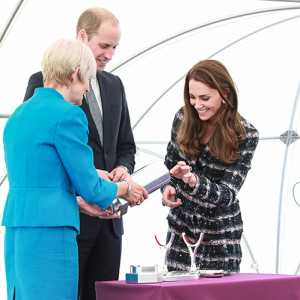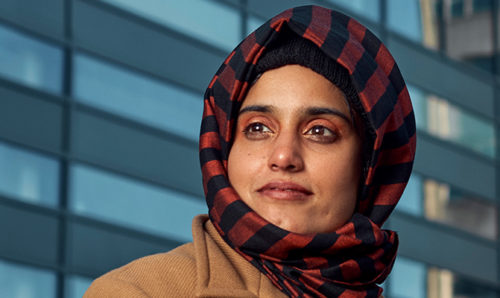MECD time capsule – laying the foundations for future innovation
UOM life 1st November 2016
Their Royal Highnesses The Duke and Duchess of Cambridge came to The University of Manchester on 14 October 2016 and sealed a time capsule at the site of the Manchester Engineering Campus Development (MECD) during their recent visit to the city.
The aluminium capsule, made by the School of Mechanical, Aerospace and Civil Engineering, will be displayed within the building once construction is completed and is due to be opened in fifty years’ time  (perhaps Prince George or Princess Charlotte might come back to do the honours). Inside the capsule are three letters describing the current global challenges and tomorrow’s potential research solutions for three of the University’s research beacons.
(perhaps Prince George or Princess Charlotte might come back to do the honours). Inside the capsule are three letters describing the current global challenges and tomorrow’s potential research solutions for three of the University’s research beacons.
The University has five research beacons – addressing global inequalities, advanced materials, cancer, energy and industrial biotechnology – which are exemplars of interdisciplinary collaboration and cross-sector partnerships that are distinctive to our University, making pioneering discoveries and improving the lives of people around the world. Researchers in our beacon areas are at the forefront of the search for innovative solutions to some of the biggest challenges facing the planet today. The Faculty of Science and Engineering is responsible for three of these research areas – advanced materials, energy and industrial biotechnology – each of which has a letter outlining the past, present and future of research and development in these fields.
“The University of Manchester has a bold vision to improve the lives of people around the world through scientific innovation where societal challenges persist… The purpose of our research in industrial biotechnology is to create radically different routes to manufacture, with sustainability at its core, that can satisfy everyday needs for industrial chemicals, materials, foods and medicines, and to establish new forms of renewable energy.” – Professor Nigel Scrutton, Director of the Manchester Institute of Biotechnology [excerpt from the industrial biotechology letter]
Almost sixty years on from when the Duke of Edinburgh opened the extension of the main building of the Faculty of Science and Engineering’s Sackville Street Building in 1957, The Duke and Duchess of Cambridge came to The University of Manchester University in October following a series of engagements around the city.
The royal couple first visited the National Graphene Institute (NGI) where, led by graphene Nobel Laureates Professor Sir Andre Geim and Professor Sir Kostya Novoselov, they were shown an array of revolutionary graphene applications including energy-efficient lighting, membranes for improved desalination technology and a graphene-skinned aircraft.
“Currently we have the largest materials science activity in Europe, attracting researchers from across the world. Our work ranges from enabling tissue regeneration to inhibiting metals degradation, from ensuring the safety of nuclear plant… to manufacturing nanomaterials (Nanoco, a start-up that makes heavy metal-free quantum dots was founded here), from aeroengine materials to aerogels.” – Professor Phil Withers, Regius Professor of Materials [excerpt from the advanced materials letter]
Following their tour of the NGI, the Duke and Duchess continued on to the site of the Manchester Engineering Campus Development (MECD). Due to open in 2020, MECD will create a world-leading teaching, learning and research campus to develop the engineers, scientists and innovators of tomorrow.
The time capsule was sealed during a ceremony on the site. Inside are: a letter to the future University community from the current President and Vice-Chancellor, Prof Dame Nancy Rothwell; a letter from Prof Martin Schröder, Dean of the Faculty of Science and Engineering; three letters from leading academics from each of the research beacons areas within the Faculty of Science and Engineering; a letter from Diana Hampson, Director of Estates; three letters from current students in the Faculty explaining their hopes for how the world will be in the future when the capsule is opened; a signed photograph the Duke and Duchess of Cambridge; a miniature replica of the British-built BAC Mono single-seat supercar car which the Duke sat in during his tour of the NGI, the world’s first car to use graphene in its production process; and a piece of gold foil encapsulated in acrylic to represent Rutherford and colleagues’ experiments in initiating the field of nuclear physics and leading to the first artificial nuclear reaction.
“Researchers across The University of Manchester are playing their parts in shaping an energy future where we are less dependent on energy and low-carbon sources of energy are accessible to the entire global population…
“At our Dalton Nuclear Institute, we are delivering world-leading research in the area of nuclear energy. This ranges from developing our understanding of materials within the nuclear environment to the designs of new small modular reactors and how we deal with waste.” – Professor Ian Cotton, Professor of High Voltage Technology and Director of Manchester Energy [excerpt from the energy letter]
The time capsule has been interned at a moment when we can reflect proudly on the University’s achievements in science and engineering and look hopefully to new and exciting research avenues with the University continuing its contribution to the application of our knowledge in addressing key global challenges.




